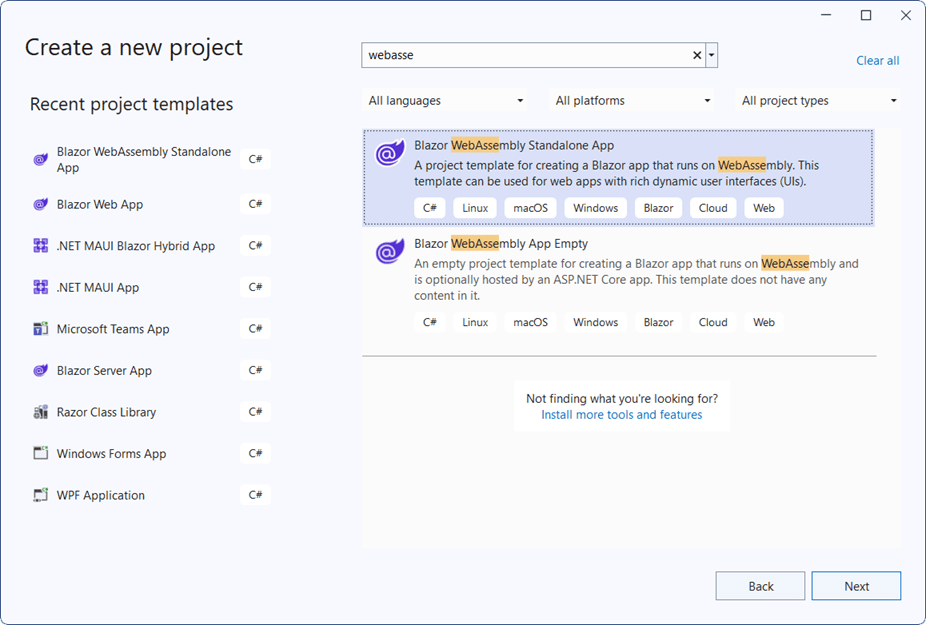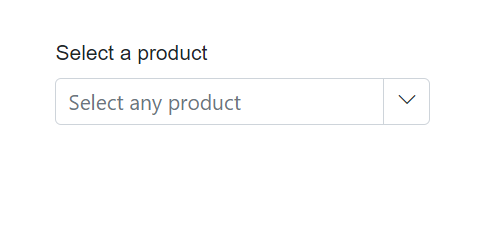Getting Started with Blazor MultiColumn ComboBox Component
24 Dec 20259 minutes to read
This guide explains how to include the Blazor MultiColumn ComboBox component in a Blazor WebAssembly app using Visual Studio, Visual Studio Code, and the .NET CLI.
To get started quickly with the Blazor MultiColumn ComboBox component, refer to this GitHub sample.
Prerequisites
Create a new Blazor App in Visual Studio
Create a Blazor WebAssembly App using Visual Studio via Microsoft Templates or the Syncfusion® Blazor Extension. For detailed instructions, refer to the Blazor WASM App Getting Started documentation.

Install Syncfusion® Blazor MultiColumnComboBox and Themes NuGet in the App
To add the Blazor MultiColumn ComboBox component, open NuGet Package Manager in Visual Studio (Tools → NuGet Package Manager → Manage NuGet Packages for Solution), then search and install Syncfusion.Blazor.MultiColumnComboBox and Syncfusion.Blazor.Themes. Alternatively, run the following commands in the Package Manager Console to achieve the same.
Install-Package Syncfusion.Blazor.MultiColumnComboBox -Version 32.1.19
Install-Package Syncfusion.Blazor.Themes -Version 32.1.19NOTE
Syncfusion® Blazor components are available in nuget.org. Refer to the NuGet packages topic for the available NuGet packages list with component details.
Prerequisites
Create a new Blazor App in Visual Studio Code
Create a Blazor WebAssembly App using Visual Studio Code via Microsoft Templates or the Syncfusion® Blazor Extension. For detailed instructions, refer to the Blazor WASM App Getting Started documentation.
Alternatively, create a WebAssembly application by using the following command in the integrated terminal(Ctrl+`).
dotnet new blazorwasm -o BlazorApp
cd BlazorAppInstall Syncfusion® Blazor MultiColumnComboBox and Themes NuGet in the App
- Press Ctrl+` to open the integrated terminal in Visual Studio Code.
- Ensure in the project root directory where the
.csprojfile is located. - Run the following commands to install the Syncfusion.Blazor.MultiColumnComboBox and Syncfusion.Blazor.Themes NuGet packages and ensure all dependencies are installed.
dotnet add package Syncfusion.Blazor.MultiColumnComboBox -v 32.1.19
dotnet add package Syncfusion.Blazor.Themes -v 32.1.19
dotnet restoreNOTE
Syncfusion® Blazor components are available in nuget.org. Refer to the NuGet packages topic for the available NuGet packages list with component details.
Prerequisites
Install the latest version of .NET SDK. If the .NET SDK is already installed, determine the installed version by running the following command in a command prompt (Windows), terminal (macOS), or command shell (Linux).
dotnet --versionCreate a Blazor WebAssembly App using .NET CLI
Run the following command to create a new Blazor WebAssembly App in a command prompt (Windows) or terminal (macOS) or command shell (Linux). For detailed instructions, refer to this Blazor WASM App Getting Started documentation.
dotnet new blazorwasm -o BlazorApp
cd BlazorAppInstall Syncfusion® Blazor MultiColumnComboBox and Themes NuGet in the App
To add the Blazor MultiColumn ComboBox component to the application, run the following commands in a command prompt (Windows), command shell (Linux), or terminal (macOS) to install the Syncfusion.Blazor.MultiColumnComboBox and Syncfusion.Blazor.Themes NuGet packages. See Install and manage packages using the dotnet CLI for more details.
dotnet add package Syncfusion.Blazor.MultiColumnComboBox -Version 32.1.19
dotnet add package Syncfusion.Blazor.Themes -Version 32.1.19
dotnet restoreNOTE
Syncfusion® Blazor components are available in nuget.org. Refer to the NuGet packages topic for the available NuGet packages list with component details.
Add Import Namespaces
Open the ~/_Imports.razor file and import the Syncfusion.Blazor and Syncfusion.Blazor.MultiColumnComboBox namespaces.
@using Syncfusion.Blazor
@using Syncfusion.Blazor.MultiColumnComboBoxRegister Syncfusion® Blazor Service
Register the Syncfusion® Blazor Service in the ~/Program.cs file of the Blazor WebAssembly App.
using Microsoft.AspNetCore.Components.Web;
using Microsoft.AspNetCore.Components.WebAssembly.Hosting;
using Syncfusion.Blazor;
var builder = WebAssemblyHostBuilder.CreateDefault(args);
builder.RootComponents.Add<App>("#app");
builder.RootComponents.Add<HeadOutlet>("head::after");
builder.Services.AddScoped(sp => new HttpClient { BaseAddress = new Uri(builder.HostEnvironment.BaseAddress) });
builder.Services.AddSyncfusionBlazor();
await builder.Build().RunAsync();
....Add stylesheet and script resources
The theme stylesheet and script can be accessed from NuGet through Static Web Assets. Include the stylesheet and script references within the <head> section of the ~/index.html file.
<head>
....
<link href="_content/Syncfusion.Blazor.Themes/bootstrap5.css" rel="stylesheet" />
<script src="_content/Syncfusion.Blazor.Core/scripts/syncfusion-blazor.min.js" type="text/javascript"></script>
</head>NOTE
Check out the Blazor Themes topic to discover various methods (Static Web Assets, CDN, and CRG) for referencing themes in Blazor application. Also, check out the Adding Script Reference topic to learn different approaches for adding script references in Blazor application.
Add Blazor MultiColumn ComboBox component
Add the Syncfusion® Blazor MultiColumn ComboBox component in the ~/Pages/Index.razor file.
<SfMultiColumnComboBox TItem="string" TValue="string" Placeholder="Select any product"></SfMultiColumnComboBox>- Press Ctrl+F5 (Windows) or ⌘+F5 (macOS) to launch the application. This renders the Syncfusion® Blazor MultiColumn ComboBox component in the default web browser.

Binding Data Source and Mapping Fields
After initialization, populate the MultiColumn ComboBox with data using the DataSource property. In this case, the MultiColumn ComboBox binds its DataSource to the Products list, which contains multiple product columns. Both the ValueField and TextField properties are set to the Name property of the Product class, ensuring that product names are displayed in the dropdown. The @bind-Value is used to bind the selected value, with an initial value of “Smart phone” pre-selected in this example.
<SfMultiColumnComboBox @bind-Value="@Value" DataSource="@Products" ValueField="Name" TextField="Name" Placeholder="Select any product"></SfMultiColumnComboBox>
@code {
public class Product
{
public string Name { get; set; }
public decimal Price { get; set; }
public string Availability { get; set; }
public string Category { get; set; }
public double Rating { get; set; }
}
private List<Product> Products = new List<Product>();
private string Value { get; set; } = "Smartphone";
protected override Task OnInitializedAsync()
{
Products = new List<Product>
{
new Product { Name = "Laptop", Price = 999.99m, Availability = "In Stock", Category = "Electronics", Rating = 4.5 },
new Product { Name = "Smartphone", Price = 599.99m, Availability = "Out of Stock", Category = "Electronics", Rating = 4.3 },
new Product { Name = "Tablet", Price = 299.99m, Availability = "In Stock", Category = "Electronics", Rating = 4.2 },
new Product { Name = "Headphones", Price = 49.99m, Availability = "In Stock", Category = "Accessories", Rating = 4.0 }
};
return base.OnInitializedAsync();
}
}
Configuring the Columns
The MultiColumn ComboBox supports auto-generating columns, which automatically creates columns based on the data source. You can also customize the column header text to reflect specific data, adjust Width for optimal display, and set TextAlign (left, center, or right) to enhance readability.
<SfMultiColumnComboBox @bind-Value="@Value" DataSource="@Products" PopupWidth="600px" ValueField="Name" TextField="Name" Placeholder="Select any product">
<MultiColumnComboboxColumns>
<MultiColumnComboboxColumn Field="Name" Width="200px" TextAlign="Syncfusion.Blazor.Grids.TextAlign.Center"></MultiColumnComboboxColumn>
<MultiColumnComboboxColumn Field="Price" Width="200px" TextAlign="Syncfusion.Blazor.Grids.TextAlign.Center"></MultiColumnComboboxColumn>
<MultiColumnComboboxColumn Field="Availability" Width="200px" TextAlign="Syncfusion.Blazor.Grids.TextAlign.Center"></MultiColumnComboboxColumn>
</MultiColumnComboboxColumns>
</SfMultiColumnComboBox>
Configuring the popup list
By default, the popup list automatically matches the width of the MultiColumn ComboBox input element, and the height is set to 350px. Customize both using the PopupHeight and PopupWidth properties.
<SfMultiColumnComboBox @bind-Value="@Value" DataSource="@Products" PopupHeight="350px" PopupWidth="400px" ValueField="Name" TextField="Name" Placeholder="Select any product"></SfMultiColumnComboBox>